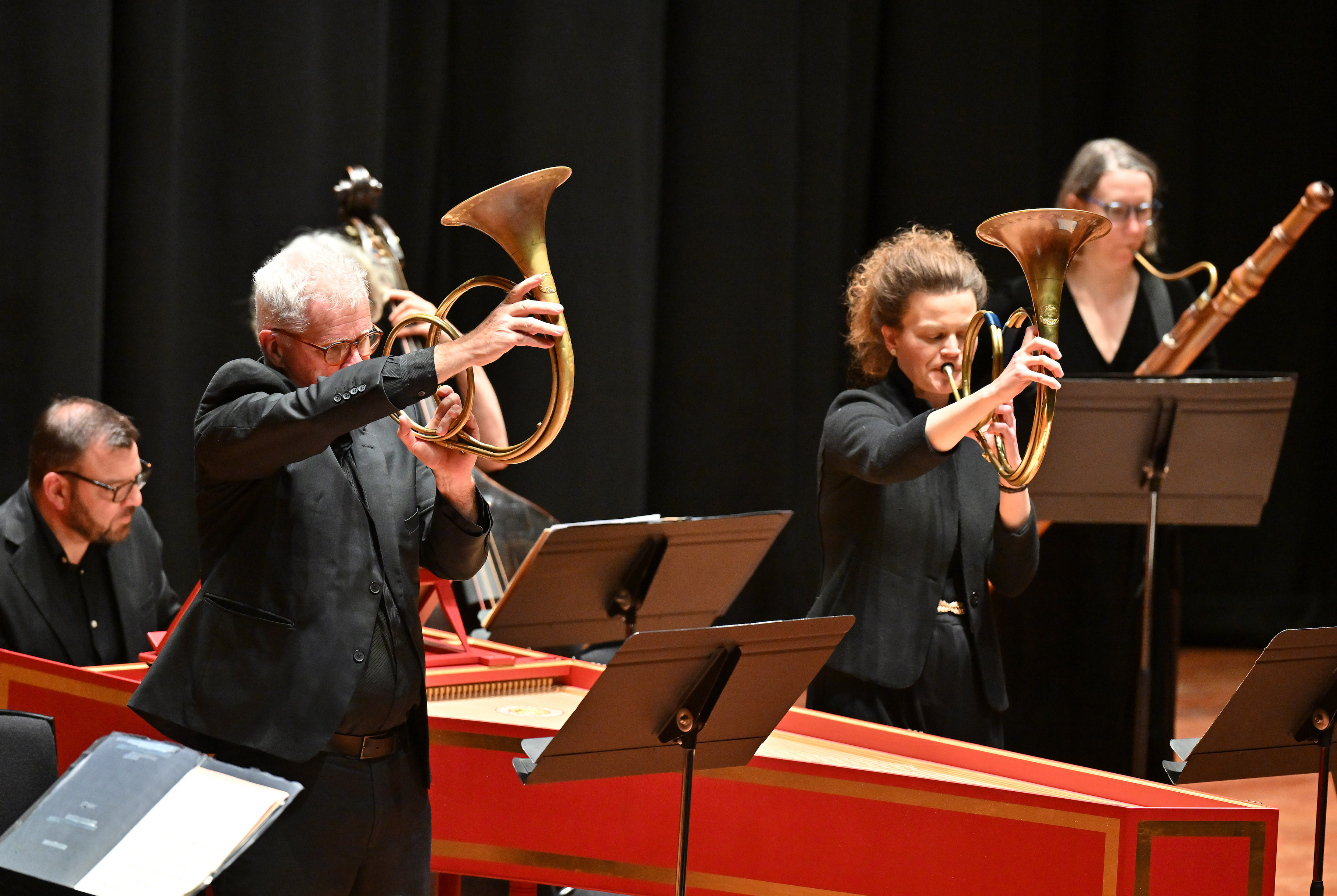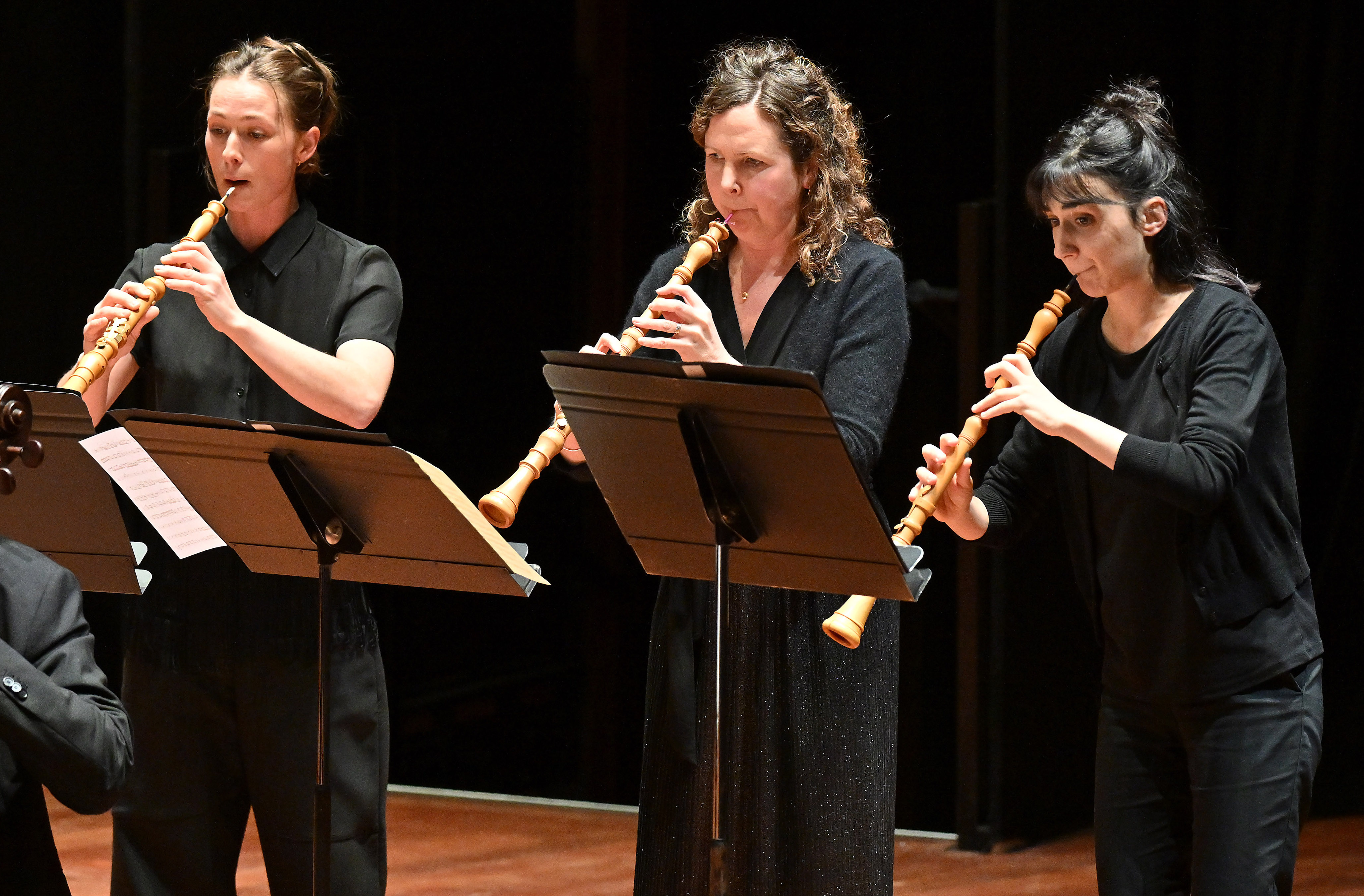Victims of their own success in the postwar era of well-recorded sound, the Brandenburg Concertos first arrived in the ears of listeners from my generation via glossy, plush and polished recordings by heavyweight orchestras of a sort that would have baffled Bach. Four decades ago, period-conscious bands began to strip the gloopy varnish off and let the strange, bold paintwork beneath shine.
Yet the look, and sound, of these six pieces “for several instruments”, rather obsequiously dedicated by the job-seeking Bach to the Margrave of Brandenburg in 1721, can still startle audiences. Last night, at the Queen Elizabeth Hall, the Orchestra of the Age of Enlightenment launched the first concerto with the raucous, rustic triplet tooting of the pair of hunting horns brandished in our faces (in every sense) by Ursula Paludan Monberg and Martin Lawrence (pictured below). With these gloriously disruptive, muddy-booted outdoor sounds, the OAE – who have these pieces lodged deeply in their musical DNA – kicked off a performance of the Brandenburgs whose dash, zest and unfussy collegiate virtuosity reminded us why that revolution in “historically informed” practice happened, and why it still pays handsome dividends. 
The OAE started and finished with brass: the bucolic peasant horns of the first concerto, tamed into salon politeness by the final sequence of dances, and the exuberant (and formidably assured) trumpet of David Blackadder in the second, which closed the programme. In between came the propulsive all-string third, the fifth with its revolutionary lead role for solo harpsichord, and prominent transverse flute, the airborne charm of the recorders in the fourth, and the unique viola duo (with supporting violas da gamba) of the sixth.
If starry solo turns studded the evening, just as enjoyable was the ensemble blend securely anchored by the harpsichord of Steven Devine (wearing his continuo hat) and Cecelia Bruggemeyer’s imperious, rock-solid bass. Violinist Margaret Faultless (pictured below with Huw Daniel) had prefaced the show with a tribute to OAE’s “sociable, congenial, collaborative approach to music-making.” We heard that in every bar. 
After this slug of home-brewed, unpasteurised Bach, the string sheen of the third concerto saw refinement of tone – notably in Faultless’s solos, both in the allegro and the (imported) adagio – matched by brisk, bouncy momentum as themes passed from instrument to instrument around the semicircle of players. You see the music take shape, and change texture. Devine’s harpsichord made the spectacular cadenza of the fifth into a keyboard ecstasy of buzzing bees and pealing bells, offset by the caressing sweetness of Lisa Beznosiuk’s flute (she’s a decorated veteran of those early period-instrument Brandenburgs).
After the interval, the fourth saw a supremely accomplished pair of recorders – Rachel Beckett, Catherine Latham – spar and scamper against Daniel’s acrobatic, but always sweetly lyrical, violin. In the andante, the recorders become Handelian sopranos in a gorgeous aria before the festive presto fugue, joyously delivered by all, that ends the piece. For me, however, the uniquely warm sonorities of the sixth, with Oliver Wilson’s viola leading the dark-toned pack with fellow-violist Elitsa Bogdanova, proved a highlight of the night. Kudos, too, to the violas da gamba (Richard Tunnicliffe, Kate Conway) as periodically broke out from a supporting role into gymnastic flights of their own. Tempi, here and throughout, felt just (and flexible) rather than quick for their own sake: far from the show-off supersonic Bach heard from some period groups.













Add comment